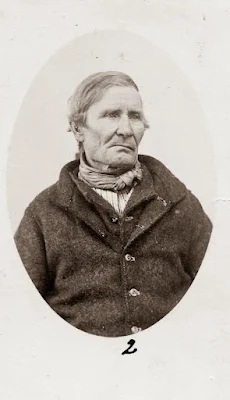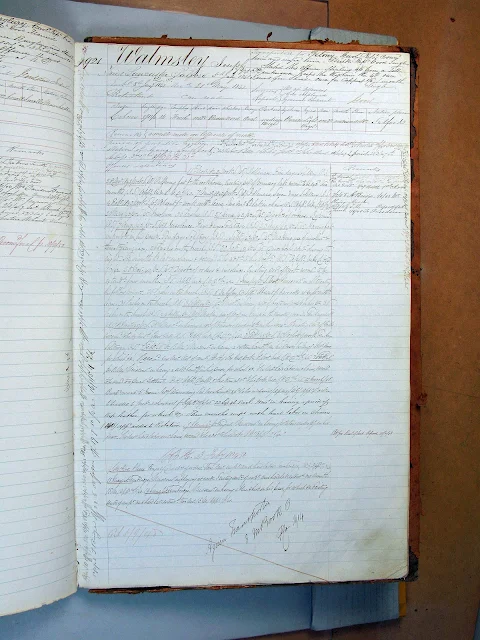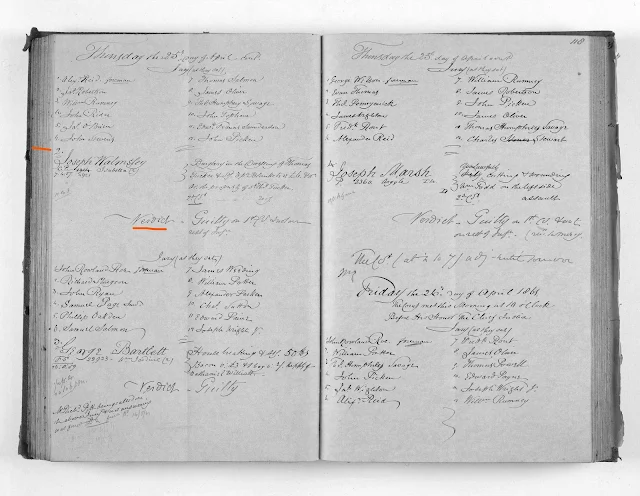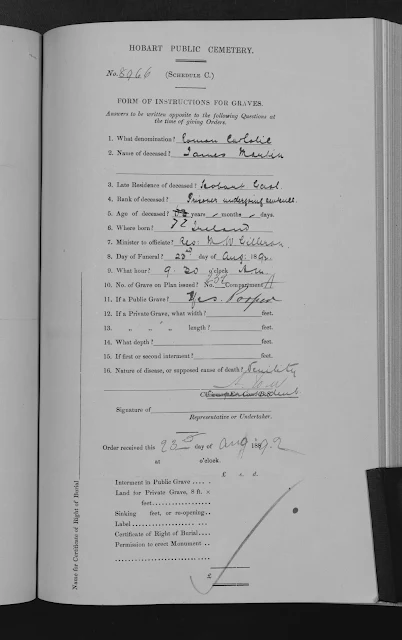National collections and exhibitions of Tasmanian mugshots in the 20th & 21st centuries.
A. H. BOYD's dismal career in public office; his misattribution by the NLA.
Thomas J. Nevin's original photographs of Tasmanian prisoners (or "Port Arthur convicts" when used in tourism discourse) which he provided on government contract for police in Hobart from 1872 to the 1886 included these two mounted carte-de-visite mugshots of prisoners William Price and William Yeomans. Both cdvs held at the National Library of Australia were spared numbering on the recto when accessioned in the 1960s from government estrays donated by Dr Neil Gunson and correctly attributed as the work of commercial photographer T. J. Nevin (1842-1923). A collection of 84 Tasmanian prisoner mugshots is currently held at the NLA. Two hundred and more of Nevin's 1870s mugshots were removed from police criminal registers ca. 1900-1916 by convictarian John Watt Beattie for sale and exhibition. Those mugshots were not spared the archivists' now-obsolete numbering and historically inaccurate information when they were acquired by the QVMAG on Beattie's death in 1930.
Fresh sets of numbers and names by museum workers subsequently appeared on all these cdvs held at the QVMAG when they were removed from Beattie's original collection in Launceston and deposited elsewhere for local, national and travelling exhibitions in the late 20th century. With digitisation of these photographic records in the first decades of the 21st century, some public institutions have omitted older, important archival information, and in the case of Thomas J. Nevin's historically correct attribution as the original photographer, the NLA in particular has compromised their records with speculations about the corrupt commandant A. H. Boyd who did not personally photograph any prisoner during his service at the Port Arthur site 1871-1873. A non-photographer, A. H. Boyd's name appeared on NLA records against their collection of Nevin's mugshots for no other reason than to support the Port Arthur Historic Site's claim for World Heritage status in 2007, and principally at the behest of a former employee with a personal agenda seeking affirmation through derogation of Nevin's work, family and descendants (see section below In His Own Words).
Prisoner William PRICE: The TMAG copy

Prisoner PRICE, William
TMAG Ref: Q15590
Numbered on recto: "100"
Photographer: Thomas J. Nevin

Verso: Prisoner PRICE, William
TMAG Ref: Q15590. Inscribed recto with number "100"
Inscribed verso with number "265" and "William Price per 'Triton' Taken at port Arthur 1874"
Photographer: Thomas J. Nevin 1879
The Tasmanian Museum and Art Gallery constructed four wooden-framed collages under glass from their collection of Thomas Nevin's prisoner mugshots for an exhibition titled Mirror with a Memory at the National Portrait Gallery, Canberra, in 2000. Nevin's cdv of William Price was placed bottom row, centre in this frame (below). However, for reasons best described as blind-sided, the TMAG staff who chose these mugshots sent the four frames to Canberra, five cdvs in the first, six per frame in the other three, with labels on the back of each wooden frame stating that the photographs were attributed to A. H. Boyd, the corrupt Commandant of the Port Arthur prison who was not a photographer by any definition of the term, nor an engineer despite any pretension on his part and especially despite the social pretensions of his descendants who began circulating the photographer attribution as a rumour in the 1980s to compensate no doubt for Boyd's vile reputation (see section In His Own Words below).
The QVMAG had correctly attributed the mugshots of convicts to police and commercial photographer Thomas J. Nevin in 1976. But by 1987 and subsequently, exhibitions were mounted at venues such as the National Portrait Gallery by "curators" who had simply collated the ONE Woolley photograph of A. H. Boyd - acquired by the TMAG in 1978 - with Nevin's convict photographs which had been physically removed from the QVMAG collection in 1983 by Elspeth Wishart for a display and exhibition at the Port Arthur Heritage Site. The majority of the prisoner photographs in these four picture frames bear a pencilled number on the front. Those numbers appear as missing prisoner photographs on the QVMAG lists of 1-300 convict cdvs which were originally archived at the QVMAG in Beattie's collection. For example, William Price is numbered "100" on recto, and is noted as missing from the QVMAG inventory when it was prepared and received here (to this researcher) in 2005.

Names as they appear on the back of the wooden frame:
Top, from left to right: James Rogers, Henry Clabley [sic], George Leathley
Bottom, from left to right: Ephraim Booth, William Price, Robert West
Photos recto and verso copyright © KLW NFC Imprint 2014-2015
Taken at the Tasmanian Museum and Art Gallery, 10 November 2014
Prisoner William PRICE: the NLA copy
This copy was spared any numbering on the recto when it was acquired in the 1960s from government estrays and accessioned at the National Library of Australia as one of several from the Gunson collection.

National Library of Australia catalogue notes:
Part of collection: Convict portraits, Port Arthur, 1874. No numbering on recto.
Title from inscription on reverse. "William Price, per Triton, taken at Port Arthur, 1874"
Link: https://nla.gov.au/nla.obj-142918514
Photographer: Thomas J. Nevin (1842-1923)
TRANSPORTATION RECORDS
Name: Price, William
Record Type: Convicts
Property: Port Arthur Penal Station
Tasman Peninsula Probation Stations
Departure date: 17 Aug 1842
Departure port: London
Ship: Triton
Place of origin: Bath, Somerset
Voyage number: 207
Police number: 8081
Index number: 57501
Record ID: NAME_INDEXES:1427135
Source: Archives Office Tasmania
Link: https://stors.tas.gov.au/NI/1427135
Name: Yeomans, William
Record Type: Convicts
Employer: Bush, William: 1855
Property: Port Arthur Penal Station
Departure date: 6 Oct 1829
Departure port: Downs
Ship: Bussorah Merchant
Place of origin: Plymouth, Devon
Voyage number: 71
Police number: 66
Index number: 79123
Record ID: NAME_INDEXES:1449339
Link:https://stors.tas.gov.au/NI/1449339
POLICE RECORDS
William Price per Triton (arrived Hobart 1842) and William Yeomans per Bussorah Merchant (arrived Hobart 1829) were granted TICKETS-OF-LEAVE on 4th July 1879. Both were photographed by T. J. Nevin on discharge on the same day in the week ending 9 July 1879. Both were sentenced to life - Wm Yeomans in 1857 for stabbing with intent, and Wm Price in 1862 for burglary. Yeomans was 63 yrs old on discharge and Price was 55 yrs old. Born in 1824, William Price died at the Hobart Hospital in May 1897, 73 years old, of a malignant disease of the rectum. William Yeomans died of senilis at the New Town Charitable Institute in September 1899. He was 91 years old.

William Price per Triton and William Yeomans per Bussorah Merchant were granted TICKETS-OF-LEAVE on 4th July 1879. Both were photographed by T. J. Nevin on discharge at Hobart in the week ending 9 July 1879.

Source: Tasmanian Reports of Crime for Police Information Only, J. Barnard Gov't printer.
Prisoner William YEOMANS: three copies

National Library of Australia catalogue notes:
Part of collection: Convict portraits, Port Arthur, 1874.
Gunson Collection file 203/7/54.
Title from inscription on reverse.; Inscription: "No 57"--On reverse.
Verso inscription: "William Yeomans, per Basorah [i.e. Bussorah] Merchant, taken at Port Arthur, 1874"
Link: https://nla.gov.au/nla.obj-142914713
Photographer: Thomas J. Nevin (1842-1923)

William Yeomans, cdv top right.
NLA Collection

Recto and verso of the NLA collection housed in plastic sleeves:
NLA copy of T. J. Nevin's cdv of prisoner William Yeomans, 1879 Hobart Gaol Campbell St.
Photographed at the NLA on 16th December 2016
Photo © KLW NFC 2016 ARR
Compare the versos: the NLA copy has the phrase "Taken at Port Arthur" added in the same orthographic style of the early 1900s as it appears on the majority of these prisoners cdv's. That phrase and the number "57" are missing on the verso of the QVMAG copy, suggesting the NLA copy was a reprint from Nevin's negative and numbered for exhibition, with the name of the prison "Port Arthur" added to suggest authenticity for prospective tourists to the site.
In all, there are three extant copies of the photograph taken once and once only in the 1870s by government contractor Thomas Nevin of prisoner William Yeomans: one at the Queen Victoria Museum and Art Gallery; one - the name misspelt as "Stormans" - at the Archives Office of Tasmania, the latter two both numbered "2" on the front, and a third which is held at the National Library of Australia with no numbering on the front, rather, it is numbered "57" on the verso, testifying to further copying from a single original glass negative by later archivists again. The NLA copy of the Yeomans carte is an archival estray donated there by Dr Neil Gunson in 1962 and accessioned correctly with T. J. Nevin's attribution. The QVMAG copy was exhibited at the Port Arthur Conservation Project in 1983 along with the cdv of William Price, now held at the TMAG.


Prisoner William Yeomans 1870s
Queen Victoria Museum and Art Gallery black and white copy made in 1985 from the sepia original
Numbering: 1958:78:22, QVM 1985: P:69
Photographer: T. J. Nevin (1842-1923)
William Yeoman's cdv at the QVMAG is the second in a series numbered recto 1, 2, and 3. Number 1 was written on George Nutt's cdv; number 2 on Yeoman's cdv, and number 3 on Bewley Tuck's cdv. As the recto on Yeomans' carte is numbered "2", its verso was most likely placed on top of the front of George Nutt's carte when the QVMAG archivist was in the process of copying them in 1958. The catalogue number for the job in 1958 was 1958:78:22, accompanied by the QVM stamp with more numbers. George Nutt's cdv shows the ink impress left by the square QVM stamp across his left cheek and collar from the verso of the second carte in the series in 1958 which was placed on top of it, that of convict carte No.2, Wm Yeomans.
For this reason, the square stamp ink is visible in the AOT image, but not in the QVMAG image, although identical in all other respects, which points to multiple copies made by the QVMAG archivist (in Launceston) for circulation to the AOT office in 1977 and in some cases, to the TMAG in 1983 (in Hobart). The original print from which 20th century copies were made may be the one held at the QVMAG but not necessarily the only duplicate which was first made by Thomas Nevin from his glass negative and used in prison and court criminal registers.
The original transcription of the convict's name and ship and the date 1874 was added much earlier, sometime between the late 1890s and 1930s when this collection of prisoner mugshots taken by Nevin for police in the 1870s was removed by John Watt Beattie from police photo books. He displayed them in his "Port Arthur Museum" of convictaria located in Hobart in the early 1900s and in travelling exhibitions associated with the fake convict hulk "Success". The collection was donated on his death in 1930 to the Queen Victoria Museum and Art Gallery, Launceston.
The most recent inscriptions on these three cdvs 1, 2 and 3 by archivists date from 1985; e.g. QVM1985:P69, and are in a childish hand. The QVMAG copy was exhibited at the Port Arthur Conservation Project in 1983, when several dozen copies were removed from Beattie's collection at the QVMAG, Launceston, and post-exhibition, deposited at the Tasmanian Museum and Art Gallery in Hobart. Further numbering was applied to the recto of those cdvs exhibited for that exhibition (Wishart, 1983).

This copy was catalogued at the Archives Office Tasmania from the copy at the QVMAG in the 1970s with Yeomans' name misspelt as "Stormans".
A. H. BOYD: in his own words, 1875
There is NO statement on the verso of the QVMAG's cdv of William Yeoman or on the other two in the series 1, 2, and 3 that these three photographs were taken at Port Arthur, nor any indication that the commandant of the prison there, A. H. Boyd personally photographed this prisoner or any other prisoner during the 1870s. The third prisoner carte in the series, that of Bewley Tuck, with the number "3" on recto, similarly lacks the inscription "Taken at Port Arthur" - the phase applied purely for exhibition purposes during the 20th century from Beattie's time.


Photographic portrait of A. H. Boyd, donated to the TMAG in 1978
Photographer: Charles A. Woolley ca. 1866
TMAG Ref:Q7661
Adolarius Humphrey Boyd was dismissed from the position of Superintendent of the Orphan School in 1864 for mistreatment of male teachers and accusations levelled at several senior women on staff. Public outrage in the press at his appointment to the position of Commandant of the Port Arthur prison in 1871 urged his unfitness to hold another government office. Less than two years later he was cited in a report as co-conspirator with Inspector of Public Works Mr. Cheverton to defraud the government over fabricated costs for maintenance and embezzlement of timber from the Port Arthur prison site. He was duly forced to resign in December 1873 with calls from both the public and members of Parliament to close the Port Arthur prison within the next year. Even so, this disgraced official A. H. Boyd was subsequently appointed Superintendent of the Cascades Establishment (Women's Prison), the position he held when called before the Commission into Penal Discipline in 1875.
Appearing in front of the Tasmanian House of Assembly Commission into Penal Discipline on 18th January 1875, A. H. Boyd, Superintendent of the Cascades Establishment (Women's Prison), gave this outline (below) of duties performed during his career. He made no mention of photographing prisoners because he neither photographed them personally, nor did he oversee their production at any time. He may have received a request sent from the Colonial Secretary's office in January 1874 for photographic copies of prisoners who had absconded - from work gangs on Hobart's Domain, not from Port Arthur - but Boyd was already absent from his Port Arthur position by December 1873, forced to resign. In any event, nothing in the Colonial Secretary's memo suggests Boyd was the actual photographer of any prisoner (though cited by his apologists for a photographer attribution), even though cameras and photographic equipment belonging to professional photographers Samuel Clifford and Thomas Nevin were readily available on site from July 1873 to May 1874 when they were requested to provide the Parliament with visual evidence of Boyd's neglect of the prison buildings and illegal deforestation of the site. Boyd also failed to mention that he was dismissed from the position of Superintendent at the Orphan School, New Town in 1864 because of his misogynistic bullying of women employees; the complaint was lodged by "the board of ladies" presided over by Mrs. C. Meredith and upheld with Boyd's subsequent dismissal.
Here is A. H. Boyd's account of his official duties in his own words, Tasmanian House of Assembly Report of Commission into Penal Discipline, August 1875, pp 2-3:
Page 2:


TRANSCRIPT
Page 2:
Questions answered by MR A.H. BOYD, Superintendent of Cascades Establishment.Page 3:
23. What office do you fill in connection with this establishment, and what is your previous experience? I hold the offices of Gaoler, House of Correction, and Superintendent of the Reformatory for Juvenile Offenders. As to my previous experience I beg to say I first entered the Convict Department in the month of March, 1847, as junior clerk at the prisoners' barracks: this appointment I held until April, 1848.
From August, 1848, to 31st March, 1860, I occupied the position first of storekeeper at Salt Water River, then of medical clerk at Impression Bay, then storekeeper at Port Arthur, and afterwards of accountant and storekeeper for Tasman's Peninsula. In March, 1861, I obtained the appointment of Superintendent of Police for the city of Hobart, which I held for nearly two years. [Boyd deliberately omits information here - his dismissal from the Orphan School in 1864 -ed.]. In May, 1871, I was appointed Civil Commandant and Superintendent of Tasman's Peninsula, which offices I held until the 31st March last*, when I was transferred to this establishment as Superintendent.Source: 1875. TASMANIA. HOUSE OF ASSEMBLY. PENAL DISCIPLINE. REPORT OF COMMISSION. Laid upon the Table by the Attorney-General, and ordered by the House to be printed, August 10, 1875
Link: https://www.parliament.tas.gov.au/tpl/PPWeb/1875/HA1875pp49.pdf
*A. H. Boyd was forced to resign in December 1873 as "Civil Commandant and Superintendent of Tasman's Peninsula" - i.e. the prison at Port Arthur - well before his transfer to the position of Superintendent of the Cascades Establishment, South Hobart. His accomplice in the theft of timber from Port Arthur was the public works overseer Mr. William Cheverton whom we shall call "Shingle-short Cheverton"... see this report in the Hobart Mercury, Friday 20 June, 1873 page 2.
Allegations such as alderman candidate and public works contractor James Spence's of gross misconduct in 1872 on the part of public officials came as no surprise a few years later to his supporter Thomas Nevin who had to contend with the notoriously corrupt Mr. W. H. Cheverton, the figure at the centre of James Spence's allegations, when Nevin with his close friend and colleague Samuel Clifford were requested by Parliament in July 1873 to pay a visit to the Port Arthur prison site to photograph the ruinous state of the buildings and surrounds. William Cheverton used his dual roles of Inspector of Public Works and private contractor to please himself. He had the publicly reviled prison Commandant A. H. Boyd in his pocket, and by December 1873, when each was found to have shared the spoils of embezzlement of public funds after they provided Parliament with false reports on the need for massive expenditure at Port Arthur, they were summarily dismissed from public office. A. H. Boyd's term at the Cascades Establishment was short-lived. By 1877 he was begging the government in the press to compensate him for dispensing with his services (Mercury, 9 May 1877).
RELATED POSTS main weblog
- Aliases, Copies and Misattribution
- Prisoner Henry CLABBY and the TMAG frame-up
- The fruitless search of wadsley-1
- Contractors Thomas J. Nevin and "dog on the chain" James Spence 1872
- Rogues Gallery: the National Library of Australia collection




















